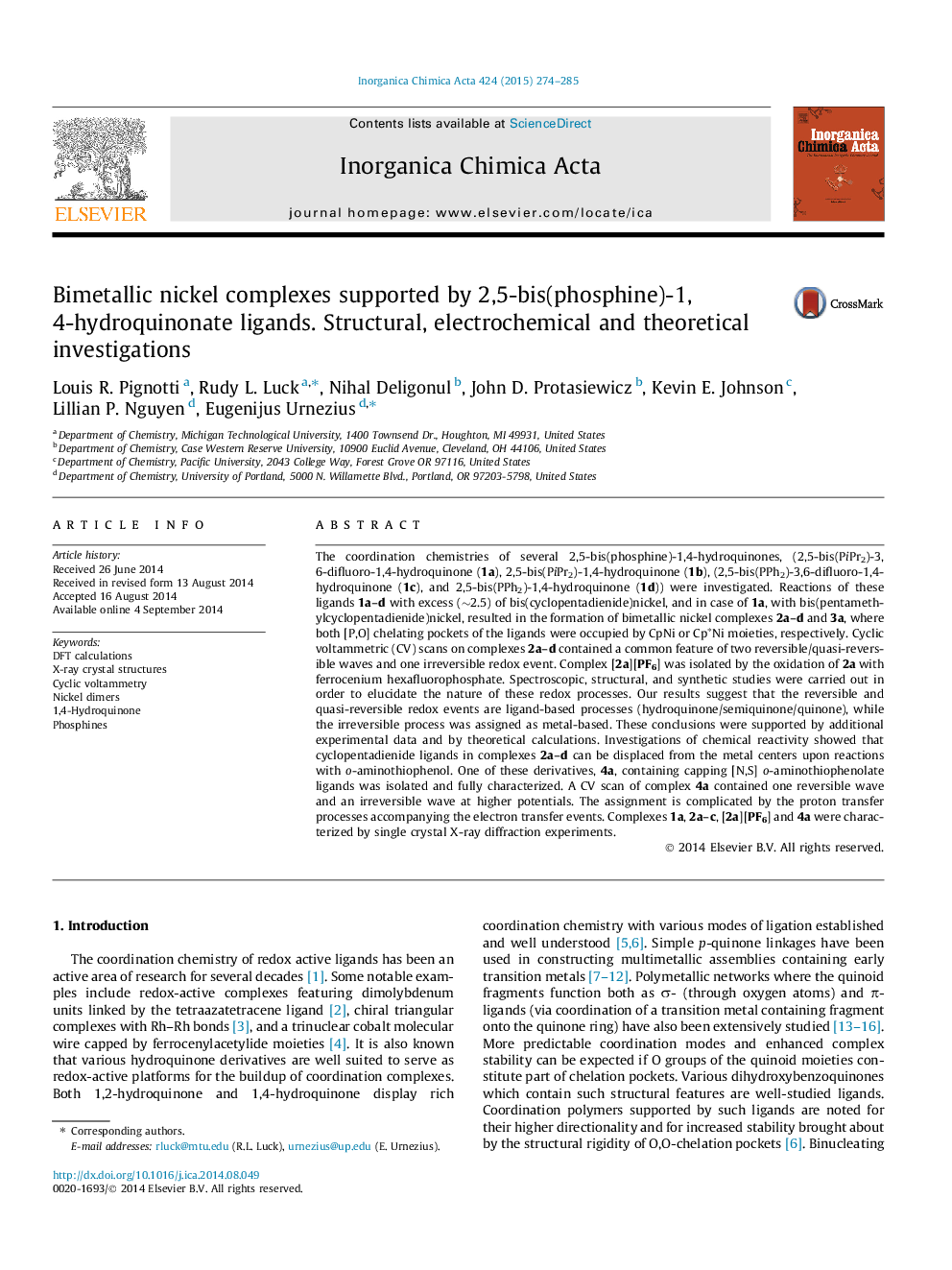| کد مقاله | کد نشریه | سال انتشار | مقاله انگلیسی | نسخه تمام متن |
|---|---|---|---|---|
| 1312162 | 1499165 | 2015 | 12 صفحه PDF | دانلود رایگان |
• Nickel dimers bridged by 2,5-bis(phosphine)-1,4-hydroquinones.
• Single crystal X-ray diffraction determined structures of six compounds.
• Cyclic voltammetry results reveal reversible and quasi-reversible redox events.
• Electrochemical assignments based on theoretical calculations.
• Complexes can serve as building blocks for extended linear arrays.
The coordination chemistries of several 2,5-bis(phosphine)-1,4-hydroquinones, (2,5-bis(PiPr2)-3,6-difluoro-1,4-hydroquinone (1a), 2,5-bis(PiPr2)-1,4-hydroquinone (1b), (2,5-bis(PPh2)-3,6-difluoro-1,4-hydroquinone (1c), and 2,5-bis(PPh2)-1,4-hydroquinone (1d)) were investigated. Reactions of these ligands 1a–d with excess (∼2.5) of bis(cyclopentadienide)nickel, and in case of 1a, with bis(pentamethylcyclopentadienide)nickel, resulted in the formation of bimetallic nickel complexes 2a–d and 3a, where both [P,O] chelating pockets of the ligands were occupied by CpNi or Cp∗Ni moieties, respectively. Cyclic voltammetric (CV) scans on complexes 2a–d contained a common feature of two reversible/quasi-reversible waves and one irreversible redox event. Complex [2a][PF6] was isolated by the oxidation of 2a with ferrocenium hexafluorophosphate. Spectroscopic, structural, and synthetic studies were carried out in order to elucidate the nature of these redox processes. Our results suggest that the reversible and quasi-reversible redox events are ligand-based processes (hydroquinone/semiquinone/quinone), while the irreversible process was assigned as metal-based. These conclusions were supported by additional experimental data and by theoretical calculations. Investigations of chemical reactivity showed that cyclopentadienide ligands in complexes 2a–d can be displaced from the metal centers upon reactions with o-aminothiophenol. One of these derivatives, 4a, containing capping [N,S] o-aminothiophenolate ligands was isolated and fully characterized. A CV scan of complex 4a contained one reversible wave and an irreversible wave at higher potentials. The assignment is complicated by the proton transfer processes accompanying the electron transfer events. Complexes 1a, 2a–c, [2a][PF6] and 4a were characterized by single crystal X-ray diffraction experiments.
2,5-Bis(phosphine)-1,4-hydroquinones were reacted with excess (∼2.5) of bis(cyclopentadienide)nickel, and in one case, with bis(pentamethylcyclopentadienide)nickel, resulting in bimetallic complexes, where both [P,O] chelating pockets of the ligands were occupied by CpNi or Cp∗Ni moieties, respectively. Complexes were analyzed by cyclic voltammetric (CV) scans, theoretical calculations and single crystal X-ray diffraction.Figure optionsDownload as PowerPoint slide
Journal: Inorganica Chimica Acta - Volume 424, 1 January 2015, Pages 274–285
